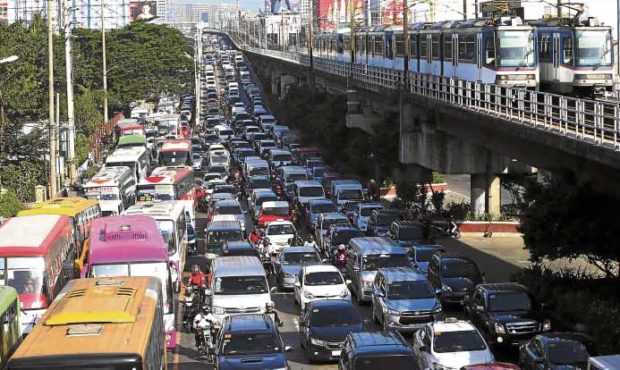Metro Manila traffic to reach ‘standstill levels’ in 5 years

SQUEEZING FOR SPACE The surge in the number of vehicles on the road is felt daily on Edsa, Metro Manila’s busiest thoroughfare, which is already well beyond its carrying capacity of 6,000 vehicles per hour per direction. —EDWIN BACASMAS
The Duterte administration’s infrastructure program may not be enough to deal with the country’s transportation woes as road congestion in Metro Manila may reach “standstill levels” by 2022, according to a study by an American consulting group.
In “Unlocking Cities,” the Boston Consulting Group, which transport network company Uber commissioned, said government plans to increase the capacity of rail-based public transport services “will not be sufficient to meet growth in transport demand” over the next five years.
The study looks into the impact of ride-sharing in Southeast Asia.
Less than 10 kph
It pointed out that mega cities like Manila, Jakarta, Ho Chi Minh, Hanoi and Surabaya — considered “Tier 3” cities — were “at risk of reaching standstill levels of congestion during peak hours by 2022” because of the rate of vehicle growth.
This meant that by then cars would run at less than 10 kilometers per hour (kph).
These cities have relatively undeveloped public transport networks or rely heavily on informal road-based transport networks.
“Tier 3 cities have ambitious plans to expand transport networks. However, roll-out will require considerable time and funding,” the study said.
It said “ride-sharing adoption of between 16 and 40 percent across these cities is needed in conjunction with public transport to maintain congestion levels today.”
To help ease road congestion, the Department of Transportation has rolled out projects like the Light Rail Transit 1 (LRT 1) extension and Metro Rail Transit 7, as well as plans to build the first Mega Manila subway.
In 2016, there were more than 2.4 million vehicles registered in Metro Manila, of which close to 1.5 million were private cars, according to the Land Transportation Office.
Vehicle sales
As of October, vehicle sales had grown by 16 percent from more than 292,000 units last year to close to 340,000 units, said the Chamber of Automotive Manufacturers of the Philippines Inc. and the Truck Manufacturers Association.
The surge in the number of vehicles on the road comes as Edsa, Metro Manila’s busiest thoroughfare, is already well beyond its carrying capacity of 6,000 vehicles per hour per direction.
The Metropolitan Manila Development Authority (MMDA) said that to date, around 7,500 vehicles are using Edsa per hour per direction.
The study, conducted from September to October and covering around 300 commuters per city, warned that congestion may become unmanageable in cities such as Manila because “80 percent of commuters surveyed indicate plans to purchase a car in the next five years.”
It noted, however, that these commuters expressed willingness to forgo buying cars if ride-sharing could meet their transport requirements on price, timeliness and availability.
“Across the cities studied, we estimate [around] 40 to 70 percent of private vehicles on the road today could be removed, if ride-share becomes a viable substitute for private vehicle ownership,” the study said.
Carpooling
Earlier, the MMDA presented the possibility of implementing a carpooling system on Edsa to reduce the number of cars using the major highway.
Uber’s study estimates that road congestion during peak hours may be reduced by up to “88 percent” should carpooling be highly adopted in Manila.
The MMDA pointed out though that it was still discussing with the Land Transportation Franchising and Regulatory Board how the measure could be best implemented since this may lead to the proliferation of “colorum” cars.
Officials are also wary that this may result in the illegal jockey industry, which was seen in Jakarta when it implemented the 3-in-1 carpool policy.